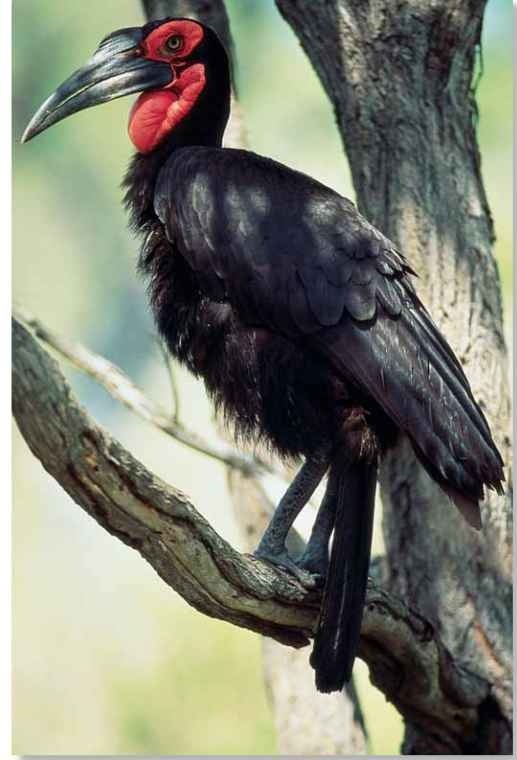ORDER
Coraciiformes
FAMILY
Bucorvidae
GENUS & SPECIES
key features
• The bird breeds cooperatively; a mated pair accepts help from immature and other adults during nest-building, incubation and fledging
• Strides purposefully across the savannah, up to 7 miles a day
• Produces a distinctive, booming call heard across the lowlands of Africa’s grassy plains
where in the world?
Found throughout African savannahs south of the equator; from southern Kenya through Rwanda, Burundi and southeast Zaire, south through Tanzania

LIFECYCLE
The southern ground hornbill practices cooperative behavior: it groups at feeding areas, assists at nursery sites and even bands together to hunt.
HABITAT
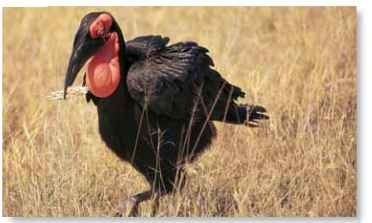
A Zimbabwe savannah The savannahs of Africa are home to the southern ground hornbill.
The southern ground hornbill makes its home in the stands of whistling-thorn acacia trees scattered throughout the grassy plains. While these trees provide shelter, the savannahs offer wide-open spaces for the hornbill to look for food.
The African savannah comes alive during the wet season.The grasses and trees turn a vibrant green, revived by the equatorial rainfall. When the plains flourish, the hornbill breeds, and parents and helpers are able to find sufficient food for the growing nestlings. But the rains eventually stop, and the grasses and leaves turn golden, forcing the hornbill to increase its territory. Foraging areas usually encompass up to 39 sq. miles.
Dominated by its older sibling, the younger hatchling rarely survives. Scientists have started removing the second-hatched chicks and raising them in captivity.
The southern ground hornbill is the largest bird species known to breed in cooperative groups — these groups may contain up to 11 breeding hornbills.
BREEDING
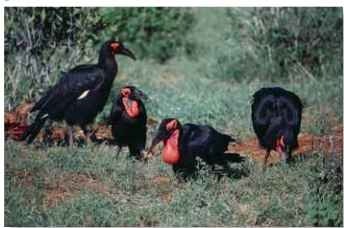
Group cooperation is a part of breeding for the hornbill. From nest-building to fledging, both immature and adult helpers coordinate and assist a dominant mating pair with all of the necessary nesting duties. The hornbill nests in natural holes, but occasionally excavates its own. Though several males feed the dominant female during courtship, only the dominant male copulates with herThe female starts incubating with the first egg; the second egg isn’t laid until 3-5 days later: Because of this time lapse,the older; larger hatchling is usually dominant and is the only one to survive.
FOOD & HUNTING
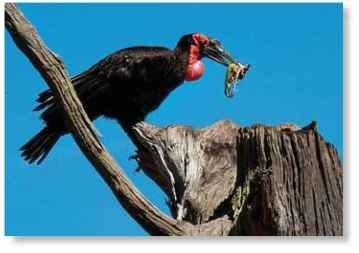
A Mixed assortment
The southern ground hornbill is a carnivore; it hunts for anything it can overpower.
CLOSE FRIENDS AND RELATIONS
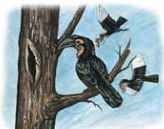
One plus two…
As a female southern ground hornbill assesses a potential nesting site, two males approach with lining materials.
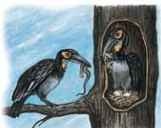
Plus three…
She accepts the nest and lays two eggs. A female helper waits for her to finish adding wood chips for insulation before feeding her.
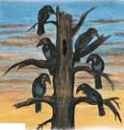
And more…
Each morning the dominant pair and all adult helpers call loudly from the nest before descending for their daily foraging trip.
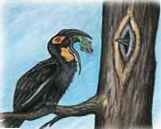
Food for you and yours
The dominant male returns to his mate first with a bill full of food for her, which includes a lizard, mouse
CONSERVATION
Since groups of hornbills usually raise only one young at a time, their numbers were declining even before the increased threat of habitat destruction.The spread of human populations and their homes has presented a peculiar threat to the hornbill. Hornbills often attack their own reflections, shattering window panes and destroying themselves.A hornbill specialist group was formed in 1983 to begin the process of stabilizing populations.
BEHAVIOR
The hornbill’s loud call each morning alerts rivals as well as its prey. The bird produces a deep hoo, hoo, hoo-hoo from its roosting site, and it can be heard from almost I mile away. It descends from its perch in an acacia or ficus tree, producing a loud noise with each wingbeat. Around midday, the bird takes a break from the hunt and relaxes quietly, sunbathing on the ground with wings stretched, while group members preen each other
The hornbill prefers walking and will cover more than I 2 miles a day, patrolling its territory in search of food. It will fly across unsuitable habitats, such as bogs or marshes, if necessary
A quick snack
A female grabs a quick grub found on the ground.
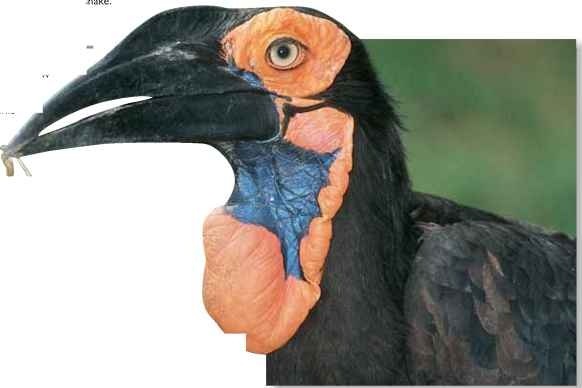
The open savannah offers fev hiding places, and the southern
ground hornbill uses ” open field to its advantage. It begins a new hunting expedition each day at dawn after its loud booming call resounds across the land.
With no place to hide, potential prey must run. The hornbill charges on its long legs, outrunning hares, squirrels and snakes. A group of hornbills often bands together to hunt large or dangerous prey. A hornbill band may rob eagles of their prey or even of their young.
On its daily foraging trips, the hornbill scans the ground for termites, toads, snails and scorpions. At other times, the hornbil must dig deeper to reveal edible earthworms. Occasionally the bird will take flight and chase prey in the air, but it usually spends up to 70% of its day walking.
PROFILE
Southern Ground Hornbill
Though it can fly, the southern ground hornbill spends most of its time walking fast and far across the savannahs of Africa.
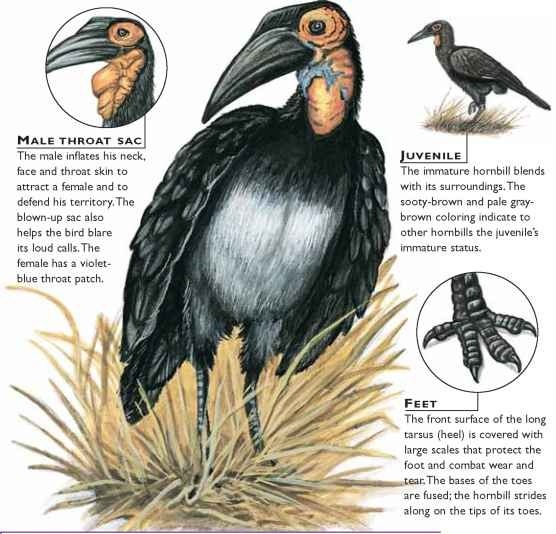
CREATURE COMPARISONS
Measuring up to 41″ long and weighing up to 8 lbs., the great pied hornbill (Buceros bicornis) is similar in size to the southern ground hornbill.They both use preen gland oil, but the black and white great pied hornbill often appears yellow because the oil stains.The pied hornbill’s diet consists of fruit, while the southern hornbill is primarily a carnivore. Unlike the southern hornbill, which has an open nest, the great pied hornbill seals its nest inside (by the female) and out (by the male) for added insulation and protection.
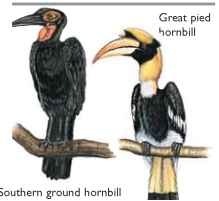
| VITAL Weight |
STATISTICS Up to 9 lbs. |
| Length | 35-39” |
| Sexual Maturity | 4-6 years |
| Breeding Season | During wet season; varies according to region |
| Number of Eggs | Usually 2, but up to 3 |
| Incubation period |
37-43 days |
| Fledging Period | 86 days |
| Breeding Interval | Usually 1 year |
| Typical Diet | Insects and small vertebrates |
| Lifespan | Unknown |
Related species
• The southern ground hornbill is part of the genus Bucorvus, which also includes the northern ground hornbill. The great pied hornbill, with its short legs, is part of the genus Buceros. But all hornbills have a straight bill with a boxy projection (casque) above it, which distinguish them from kingfishers, bee-eaters and rollers, also found in the order Coraciiformes.
